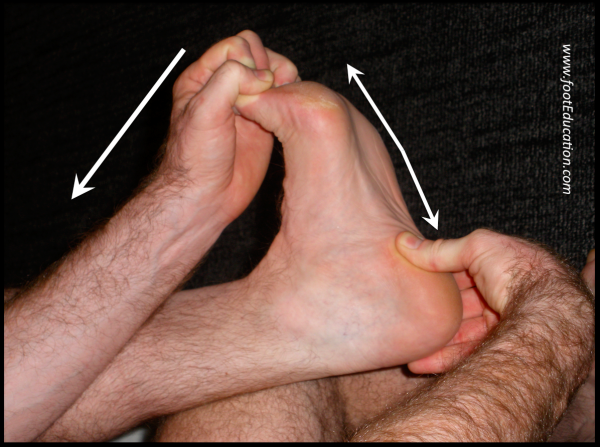Plantar fasciitis is the inflammation or degeneration of a ligament that runs from the heel to the ball of the foot. For reasons that are not yet fully understood certain people might develop this condition that, as benign as it is, can be very debilitating.

Patients typically complain of pain and burning at the bottom of the heel especially in the morning when getting out of bed or after standing/walking following a prolonged period of immobilization (sitting at a desk, watching TV, etc). In many patients, the pain resolves as they start walking, or when wearing cushioned shoes.
Plantar fasciitis generally responds well to non-operative treatments that need to be followed for at least 1 month. These include:
A deep massage of the area of the heel that hurts the most. This needs to be done while keeping the big toe stretched up during the massage so as to maximize the effects of the stretch (see photo). Typically patients are recommended a massage for 5-10 minutes 3-4 times per day.
Stretching of the calf, 5 minutes 3 times per day. Tight calves can pull on the plantar fascia thus worsening the condition.
Ice massage: take a small plastic bottle of water and freeze it. Then, step on the bottle and roll it under the foot to help massage and stretch the plantar fascia.
Use a night splint (purchasable online) to help stretch the calf and plantar fascia at night or any time you are sitting for prolonged periods.
Use memory foam shoe inserts or gel heel pads to help cushion the heel.
Avoid walking barefoot.
If the above treatments do not improve the symptoms after 1 month, then seeing an orthopedic surgeon with fellowship training in the foot and ankle is recommended. At the visit, the physician will order X-rays to rule out fractures.
At this point, the physician might discuss performing a cortisone injection in the plantar fascia. The injection might temporarily increase pain for 1-2 days in a minority of patients but is not usually concerning. Injections should not be performed more than 2 times to avoid the risk of rupture of the plantar fascia and atrophy of the fat pad under the heel. It is important to remember that the injection should not replace the exercises mentioned above.
Another technique that can help with healing is called low-energy shockwave therapy. This consists of sending shockwaves to the plantar fascia using a probe once a week for 3-4 weeks. The shockwave treatment can be performed in isolation or in association with the cortisone injection.
Lastly, should the pain not resolve, surgery might be recommended. The orthopedic surgeon might discuss a minimally invasive release of the plantar fascia with/without a release of the tight calf tendon. The 15-minute surgery is an outpatient procedure performed under sedation and regional anesthesia. The success rate of surgery is about 70%.